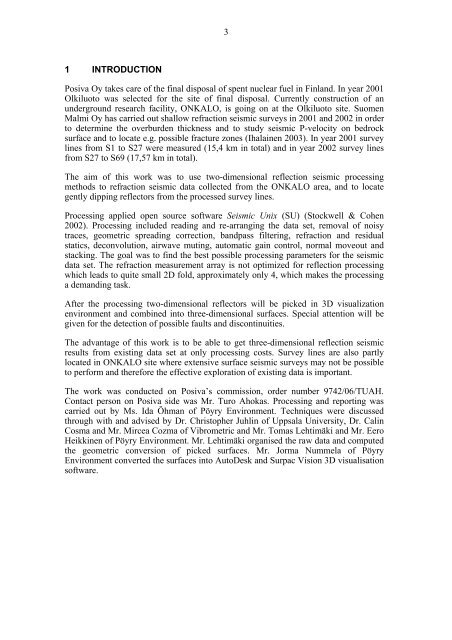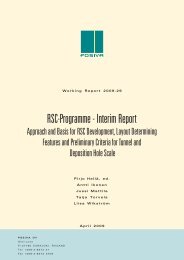Seismic 2D Reflection Processing and Interpretation of ... - Posiva
Seismic 2D Reflection Processing and Interpretation of ... - Posiva
Seismic 2D Reflection Processing and Interpretation of ... - Posiva
Create successful ePaper yourself
Turn your PDF publications into a flip-book with our unique Google optimized e-Paper software.
31 INTRODUCTION<strong>Posiva</strong> Oy takes care <strong>of</strong> the final disposal <strong>of</strong> spent nuclear fuel in Finl<strong>and</strong>. In year 2001Olkiluoto was selected for the site <strong>of</strong> final disposal. Currently construction <strong>of</strong> anunderground research facility, ONKALO, is going on at the Olkiluoto site. SuomenMalmi Oy has carried out shallow refraction seismic surveys in 2001 <strong>and</strong> 2002 in orderto determine the overburden thickness <strong>and</strong> to study seismic P-velocity on bedrocksurface <strong>and</strong> to locate e.g. possible fracture zones (Ihalainen 2003). In year 2001 surveylines from S1 to S27 were measured (15,4 km in total) <strong>and</strong> in year 2002 survey linesfrom S27 to S69 (17,57 km in total).The aim <strong>of</strong> this work was to use two-dimensional reflection seismic processingmethods to refraction seismic data collected from the ONKALO area, <strong>and</strong> to locategently dipping reflectors from the processed survey lines.<strong>Processing</strong> applied open source s<strong>of</strong>tware <strong>Seismic</strong> Unix (SU) (Stockwell & Cohen2002). <strong>Processing</strong> included reading <strong>and</strong> re-arranging the data set, removal <strong>of</strong> noisytraces, geometric spreading correction, b<strong>and</strong>pass filtering, refraction <strong>and</strong> residualstatics, deconvolution, airwave muting, automatic gain control, normal moveout <strong>and</strong>stacking. The goal was to find the best possible processing parameters for the seismicdata set. The refraction measurement array is not optimized for reflection processingwhich leads to quite small <strong>2D</strong> fold, approximately only 4, which makes the processinga dem<strong>and</strong>ing task.After the processing two-dimensional reflectors will be picked in 3D visualizationenvironment <strong>and</strong> combined into three-dimensional surfaces. Special attention will begiven for the detection <strong>of</strong> possible faults <strong>and</strong> discontinuities.The advantage <strong>of</strong> this work is to be able to get three-dimensional reflection seismicresults from existing data set at only processing costs. Survey lines are also partlylocated in ONKALO site where extensive surface seismic surveys may not be possibleto perform <strong>and</strong> therefore the effective exploration <strong>of</strong> existing data is important.The work was conducted on <strong>Posiva</strong>’s commission, order number 9742/06/TUAH.Contact person on <strong>Posiva</strong> side was Mr. Turo Ahokas. <strong>Processing</strong> <strong>and</strong> reporting wascarried out by Ms. Ida Öhman <strong>of</strong> Pöyry Environment. Techniques were discussedthrough with <strong>and</strong> advised by Dr. Christopher Juhlin <strong>of</strong> Uppsala University, Dr. CalinCosma <strong>and</strong> Mr. Mircea Cozma <strong>of</strong> Vibrometric <strong>and</strong> Mr. Tomas Lehtimäki <strong>and</strong> Mr. EeroHeikkinen <strong>of</strong> Pöyry Environment. Mr. Lehtimäki organised the raw data <strong>and</strong> computedthe geometric conversion <strong>of</strong> picked surfaces. Mr. Jorma Nummela <strong>of</strong> PöyryEnvironment converted the surfaces into AutoDesk <strong>and</strong> Surpac Vision 3D visualisations<strong>of</strong>tware.
















